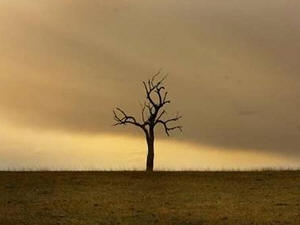The Drought and your Landscape
 Some summers we watch the effects of the drought victimize our lawns and gardens. With little or no effort, the brown lawns become green again next Spring, and the annuals will be planted again next May, as they are every year. What about the other valuable assets to your landscape, your trees and shrubs? What effects will a sustained drought have on them? What can you do to help them survive?
Some summers we watch the effects of the drought victimize our lawns and gardens. With little or no effort, the brown lawns become green again next Spring, and the annuals will be planted again next May, as they are every year. What about the other valuable assets to your landscape, your trees and shrubs? What effects will a sustained drought have on them? What can you do to help them survive?
The effects of a drought could be devastating and long-lasting when it comes to trees and shrubs. Some of the symptoms may be obvious right away, but many trees will endure a slow decline for several years to come.
Trees can show drought stress in a variety of ways; leaves may wilt, droop, turn yellow, show early fall color, turn brown at the tips or margins, curl or show all of these symptoms. Green leaves, stems, roots and fruits may all appear smaller. The leaves of some trees such as Ash, Linden, Hickory and Black Locust will usually turn yellow and drop early. Many plants such as Burning Bush, River Birch, Flowering Dogwood, Callery Pear and certain Red Maple cultivars may show early fall color. Lack of water may cause Pine needles to bend or droop near the needle base. Needles either fade and turn brown or remain green and permanently bent.
In times of drought, trees are like humans; the first ones to go will be older trees that are less able to cope with the heat and stress. The younger trees are also susceptible mostly because they have been recently transplanted.
Another possible effect of water stress is the plant’s increased susceptibility to some insects and diseases. Insects and diseases often prey on trees weakened by environmental stresses such as drought.
It’s never too late to help your plants. Water any stressed plant to encourage recovery. For large trees, sprinklers are probably the best watering method. Apply enough water to penetrate deeply (about four inches) within the dripline. Newly transplanted plants benefit more from a deep watering every few days than from a light sprinkling every day. Water early in the morning to reduce water loss through evaporation.
Fertilizing landscape plants promotes their general health and vitality, making them more resistant to insect and disease attack. Fertilization also encourages root and shoot growth and makes plants more tolerant of environmental stresses such as heat and drought.
There are many ways to determine if woody plants require fertilization. In general, if twigs exhibit 2-6 inches of new growth, fertilization should be considered. If twig elongation (new growth) measures less than 2 inches, fertilization is recommended.
Liquid soil injection by hydraulic pressure is a fast and economical way to apply fertilizers. A slow-release liquid fertilization will benefit the plant for up to two years. Spring and fall are good times for this treatment. Give us a call to set-up a fertilization plan for your property.

